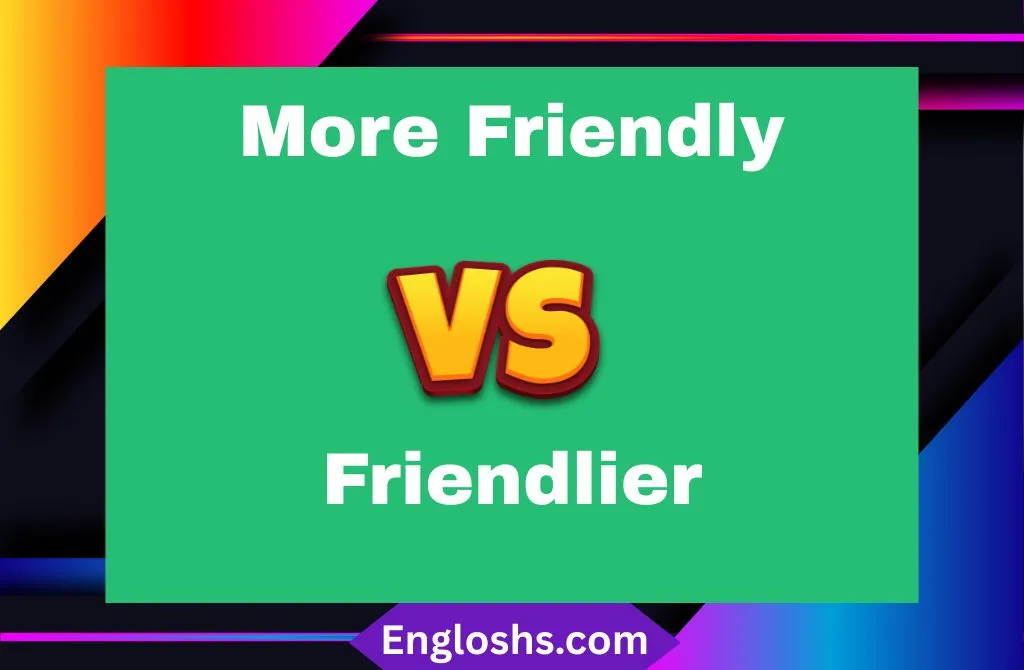We’ve all been there. You’re writing an email or chatting with someone and you pause: should you say “friendlier” or “more friendly”? They both sound right, but which one is actually correct?
Here’s the quick answer: “friendlier” is the grammatically preferred form, but “more friendly” is also widely used in specific contexts — and surprisingly, sometimes it’s the better option.
Let’s unpack the differences, figure out when to use each form, and explore plenty of examples so you never second-guess yourself again.
Should you say “friendlier” or “more friendly”? Both forms are grammatically correct, but each has a specific use depending on context. Let’s explore the differences with easy examples so you never have to second-guess.
Understanding the Basics of Comparative Adjectives in American English
In English, comparatives are used to compare two things. Usually, this is done in one of two ways:
- By adding “-er” to the adjective (e.g., taller, happier, friendlier)
- By using “more” + the adjective (e.g., more beautiful, more careful, more interesting)
General Rule of Thumb:
| Adjective Type | Comparative Form | Example |
|---|---|---|
| One-syllable | Add -er | fast → faster |
| Two-syllable (ending in -y) | Change y to i + -er | happy → happier |
| Two-syllable (not ending in -y) or longer | Use “more” + adjective | modern → more modern |
So, where does “friendly” fall?
The Intricacies of “More Friendly” and “Friendlier”: A Detailed Analysis
The adjective friendly has two syllables and ends in -ly, making it an unusual case.
According to traditional grammar rules:
- Since it ends in -ly (like lovely or lively), “more friendly” should be the correct comparative.
- However, in practice, “friendlier” is more commonly accepted and used.
Dictionary Consensus:
Most major dictionaries, including Merriam-Webster and Oxford English Dictionary, list “friendlier” as the standard comparative. Yet, they also acknowledge “more friendly” as a valid alternative — especially in certain contexts.
When to Use “More Friendly” in Everyday Language
So why do people say “more friendly” if “friendlier” is correct?
Here’s when “more friendly” works better:
- When you want to add emphasis
- When you’re comparing abstract concepts or groups
- When you want to sound slightly more formal or careful
Examples:
- “The new HR policy seems more friendly to working parents.”
- “Her tone was more friendly than usual — almost warm.”
In these examples, more friendly sounds a bit more thoughtful or analytical, which suits formal or neutral contexts.
Comparing Multiple Personalities: The Use of “More Friendly”
Sometimes, comparisons involve more than two entities or complex traits, which makes “more friendly” the clearer choice.
Compare these:
✅ “John is friendlier than Steve.”
✅ “Among the candidates, Lisa’s approach felt more friendly and approachable.”
The second sentence compares multiple elements — not just friendliness, but approachability too. That makes more friendly the better fit for clarity.
Creating More Impact: Instances Where “More Friendly” Shines
Here’s where more friendly really stands out:
- Technical writing: “This software update is more user-friendly.”
- Corporate or formal speech: “We’re working to create a more friendly customer service environment.”
- Marketing language: “Experience a more friendly ride with our upgraded train service.”
Why It Works:
“More friendly” sounds more intentional, calculated, and polished. It’s less about emotion and more about measured friendliness.
Exploring the Use of “Friendlier” in American English
“Friendlier” is shorter, punchier, and — let’s be honest — just sounds more natural in everyday conversation.
Use “friendlier” when:
- You’re speaking informally.
- Comparing two people directly.
- Writing dialogue or casual content.
Examples:
- “She’s way friendlier than her sister.”
- “This café feels friendlier than the last one.”
- “The dog became friendlier after a few treats.”
It flows better in speech and makes your tone sound more relaxed and natural.
Illustrative Examples: “More Friendly” vs “Friendlier” in Context
Here’s a table to show when to use each:
| Scenario | Best Choice | Example |
|---|---|---|
| Casual conversation | Friendlier | “He’s friendlier than I expected.” |
| Comparing corporate strategies | More friendly | “We adopted a more friendly tone in our messaging.” |
| Comparing one-on-one behavior | Friendlier | “The new teacher is friendlier than the last one.” |
| Describing brand or product tone | More friendly | “Our app now features a more friendly interface.” |
“More Friendly” or “Friendlier”: Special Cases and Exceptions
What about “user-friendly,” “eco-friendly,” or “budget-friendly”?
These compound adjectives change the rules a bit. You can’t just say:
- “More user-friendlier” ❌
- “More eco-friendlier” ❌
But you can say:
- “More user-friendly” ✅
- “More eco-friendly” ✅
In these cases, more is part of a broader compound, and “friendlier” doesn’t apply at all.
Eco-Friendly Conversations: A Rule-breaking Exception
Let’s take the phrase “eco-friendly.” You’ll often hear phrases like:
- “We need more eco-friendly solutions.” ✅
- “We’re switching to more environmentally friendly packaging.” ✅
Here, “eco-friendly” is treated as a fixed compound. “Friendlier” just wouldn’t work:
- “Friendlier to the environment” — yes, this is okay.
- “Eco-friendlier” — nope, sounds awkward.
Quick Tip:
Use “more friendly” when referring to established compound adjectives like:
- User-friendly
- Environmentally friendly
- Pet-friendly
The Interchangeable Use of “More Friendly” and “Friendlier” in Informal Speech
In everyday American English, you’ll hear both phrases used interchangeably — and honestly, that’s fine in casual settings.
Spoken examples:
- “My neighbor’s dog is getting more friendly every day.”
- “Your mom’s friend seems friendlier than I expected.”
Both are grammatically acceptable, and unless you’re submitting formal writing or a publication, no one will bat an eye.
Final Verdict: Tips on Choosing the Right Form for Clear Communication
Here’s how to make the right choice every time:
Choose “friendlier” when:
- You’re speaking casually or writing informally.
- Comparing two people or things directly.
- You want a friendly, conversational tone.
Choose “more friendly” when:
- You’re writing formally, academically, or professionally.
- Describing abstract qualities or technical elements.
- Emphasizing change, improvement, or policy.
Pro Tip: If in doubt, go with friendlier in speech and more friendly in writing — but know that both are correct.
❓FAQs Section
1. Which is correct: “more friendly” or “friendlier”?
Both are correct, but “friendlier” is preferred in informal speech, while “more friendly” works better in formal or nuanced contexts.
2. When should I use “friendlier” instead of “more friendly”?
Use “friendlier” when speaking casually or comparing two people or things directly—for example, “This dog is friendlier than the other.”
3. Is “more friendly” wrong in formal writing?
Not at all. “More friendly” is perfectly acceptable in formal writing, especially when emphasizing gradual change, tone, or abstract traits.
4. Can I say “eco-friendlier” or “user-friendlier”?
No, compound adjectives like “eco-friendly” or “user-friendly” should use “more”—e.g., “more eco-friendly” or “more user-friendly.”
5. Why do both versions exist in English?
English allows flexibility. “Friendlier” is the traditional comparative, but “more friendly” evolved to fit situations where clarity, emphasis, or tone require it.
6. Which should I use in emails or business writing?
Use “more friendly” in business or technical writing. It sounds more polished and fits well with formal tone and abstract descriptions.
Final Thought:
“Good grammar is not about being perfect. It’s about being clear.” — Anonymous
Whether you choose “friendlier” or “more friendly,” what matters most is your message. Now that you know the difference — and when to use each — you can write and speak with total confidence.





